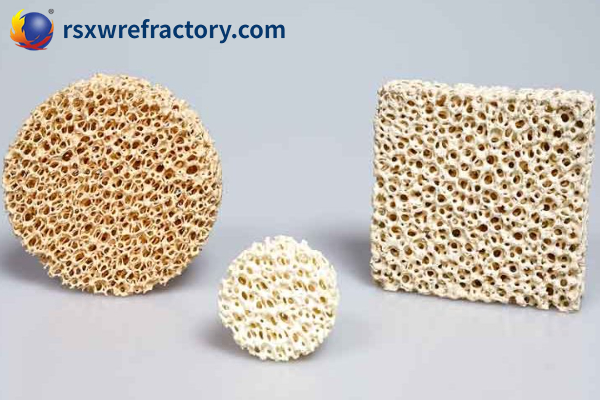Керамический фильтрующий пенопласт представляет собой пористый материал с высокотемпературными характеристиками.. Размер пор варьируется от нанометра до микрометра., пористость находится между 20% и 95%, и рабочая температура от комнатной температуры до 1600 ℃. Пена керамика имеет высокую специфическую область, Высокая пористость, низкая плотность, низкая теплопроводность, и селективная проницаемость для жидкой и газовой среды. Он также имеет превосходные характеристики высокой механической прочности, Хорошая химическая стабильность при высоких температурах, и хорошая адсорбция.
Процесс производства пены керамического фильтра
1. Органический (полимер) Процесс погружения пены

Керамическая суспендия пропитана органической пеной, и органическая пена сжигается после сушки. С трехмерной трехмерной сетевой скелетной структурой органической пены, Подготовленная суспендия равномерно покрывается органическим корпусом сети пены, и поры, полученные после сжигания органической пены, являются сетевыми. Ключевой момент заключается в выборе органической пены, и необходимо рассмотреть размер пор органической пены, гидрофильность и устойчивость пены, И горящая потеря.
2 . Процесс пенообразования
Процесс пенообразования состоит в том, чтобы добавить органические или неорганические химические вещества в керамические компоненты, производить летучие газы с помощью химических реакций, генерировать пену, а затем сделайте пенопластовую керамику с помощью сушки и спекания.

3. Добавление процесса порового агента
Добавляя пор-формирующие агенты к керамическим ингредиентам, Пори-формирующие агенты занимают определенное пространство в зеленом теле, а затем после спекания, Порные агенты оставляют матрицу, чтобы сформировать поры.
4. Сол-гель процесс
Процесс Sol-Gel используется для приготовления пенопластовых керамических материалов. Во время трансформации SOL в гель, Вязкость системы быстро увеличивается, тем самым стабилизируя пузыри, генерируемые на ранней стадии и облегчая пену. Он подходит для микропористых керамических материалов с нанометровыми размерами пор и пенопласт -керамическими материалами с высокой регулярностью.
5. Гелевый процесс литья
Использование непористого плесени и использования химической реакции внутри суспензии или небольшого количества добавок, чтобы затвердеть керамическую суспензию in situ, чтобы сформировать зеленое тело, Получение зеленого тела с хорошей микроскопической однородностью и формой. Это широко используемый метод формования, который может пенить суспензию и позволить жидкой пене полимеризовать и затвердеть in situ.

 Группа Жуншэн
Группа Жуншэн

Вичат
Сканируйте QR-код с помощью WeChat